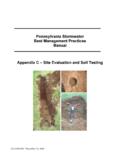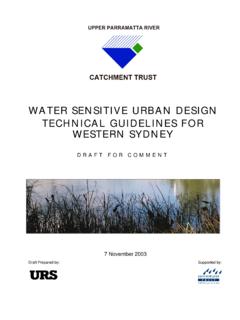Transcription of APPENDIX A - INFILTRATION TESTING - rcflood.org
1 APPENDIX A - INFILTRATION TESTING . INFILTRATION BMPs use the interaction of chemical, physical, and biological processes between soil and water to filter out sediments and constituents from stormwater. INFILTRATION BMPs require a maximum drawdown time to avoid nuisance issues. Since drawdown time is contingent on the INFILTRATION rate of the underlying soil, tests are used to help establish the vertical INFILTRATION rate of the soil below a proposed INFILTRATION facility. The tests attempt to simulate the physical process that will occur when the facility is in operation. Section 1 - General Requirements - Summary of Requirements The following is a brief summary of the requirements for all INFILTRATION test reports submitted to the Engineering Authority (EA)1 for the purpose of water quality BMP design. A checklist form is included at the end of this document. 1. Where INFILTRATION TESTING is to be performed (as directed by the EA or in the WQMP), the measured INFILTRATION rate of the underlying soil must be determined using either the single ring infiltrometer test (as described in ASTM D 5126, Section ), the double ring infiltrometer test (ASTM D 3385), the well permeameter method (USBR 7300-89), or a percolation test per County of Riverside Department of Environmental Health (RCDEH) test procedures.
2 A general explanation of these test methods can be found in Section 2 of this APPENDIX . The minimum number of tests required can be found in Table 1 and is dependent upon the type of INFILTRATION test performed. 2. Test pits and borings (ASTM D 1452) may be used to determine the USCS series and textural class (SM, CL, etc.) of the soil horizons, the thickness of soil and rock strata, and to estimate the historical high groundwater mark2. Test pits or boring logs must be of sufficient depth to establish that a minimum of 5 feet of permeable soil exists below the INFILTRATION facility and that there is a minimum of 10 feet between the bottom of the INFILTRATION facility and the historical high groundwater mark (Sections and ). The required number of test pits or borings are listed in Table 1. 3. A final report, prepared by a registered civil engineer, geotechnical engineer, certified engineering geologist or certified hydrogeologist shall be provided to the EA which demonstrates through INFILTRATION TESTING and/or soil logs that the proposed facility location is suitable for the proposed INFILTRATION facility and an INFILTRATION rate shall be recommended.
3 In addition, any requirements associated with impacts to a landslide, erosion or steep slope hazard area should also be addressed in the final report. (Section ). 1. County Transportation, Coachella Valley Water District and the City Engineer for incorporated cities within the County may choose to alter these guidelines and may have different/additional requirements. These entities, along with the District, will be referred to as the Engineering Authority (EA). 2. The historical high groundwater mark is defined as the groundwater elevation expected due to a normal wet season and shall be obtained by boring logs or test pits. Riverside County - Low Impact Development BMP Design Handbook rev. 9/2011. Page 1. 4. Tests may be performed only by individuals trained and educated to perform, understand and evaluate the field conditions. The individual(s) supervising the field work must be named in the final report as described in Item 3. (Section ). 5. Preliminary site grading plans shall be provided to the EA showing the proposed BMP.
4 Locations along with section views through each BMP clearly identifying the extents of cut/fill relative to native soil. (See Section ). 6. For sites where INFILTRATION BMPs have been determined to be feasible and will be used, INFILTRATION tests shall be performed within the boundaries of the proposed INFILTRATION BMP and at the bottom elevation ( INFILTRATION surface) of the proposed INFILTRATION BMP to confirm the suitability of INFILTRATION . (See Photo 5). A Note on INFILTRATION Rate vs. Percolation Rate . A common misunderstanding exists that the percolation rate obtained from a percolation test is equivalent to the INFILTRATION rate obtained from a single or double ring infiltrometer test. While the percolation rate is related to the INFILTRATION rate, percolation rates tend to overestimate INFILTRATION rates and can be off by a factor of ten or more. However, as is discussed in Section , the percolation rate can be converted to a reasonable estimate of the INFILTRATION rate using the Porchet Method.
5 Applicability of INFILTRATION BMPs The WQMP guidance applicable to a project (based on the watershed location of the project), may include specific criteria for evaluating whether INFILTRATION BMPs are feasible for a particular project. Where the WQMP requires that INFILTRATION TESTING be performed as part of an INFILTRATION feasibility evaluation, a TESTING method approved by the EA shall be used. The District requires the use of the methods described in Section 2 herein. The remainder of Section 1 herein describes requirements that must be implemented whenever an INFILTRATION BMP is to be implemented. - Grading Plans Many projects require a significant amount of grading prior to their construction. It is important to determine if the BMP will be placed in cut or fill since this may affect the performance of the BMP or even the soil. As such, preliminary site grading plans showing the proposed BMP. locations are required along with section views through each BMP clearly identifying the extents of cut or fill.
6 In addition, since it is imperative that any TESTING be performed at the proper elevations and locations, it is highly recommended that the preliminary site grading plans be provided to the engineer/geologist prior to any tests being performed. Riverside County - Low Impact Development BMP Design Handbook rev. 9/2011. Page 2. - Cut Condition Where the proposed INFILTRATION BMP is to be located in a cut condition, the INFILTRATION surface level at the bottom of the BMP might be far below the existing grade. For example, if the INFILTRATION surface of a proposed BMP is to be located at an elevation that is currently beneath 15. feet of cut, how can the proposed INFILTRATION surface be tested? In order to determine an INFILTRATION rate where the proposed INFILTRATION surface is in a cut condition, the following procedures may be used: 1. The USBR 7300-89, Procedure for Performing Field Permeability TESTING by the Well Permeameter Method (Section ). Note: the result must be converted to an INFILTRATION rate.
7 2. The Percolation Test per RCDEH (Section ) may be used. Note: the result must be converted to an INFILTRATION rate. Refer also to the WQMP guidance document applicable to the project, which may identify applicability criteria for INFILTRATION BMPs in cut conditions. - Fill Condition If the bottom of a BMP ( INFILTRATION surface) is in a fill location, the INFILTRATION surface may not exist prior to grading. How then can the INFILTRATION rate be determined? For example, if a proposed INFILTRATION BMP is to be located in 12 feet of fill, how could one reasonably establish an INFILTRATION rate prior to the fill being placed? Unfortunately, no reliable assumptions can be made about the in-situ properties of fill soil. As such, the bottom, or rather the INFILTRATION surface of the BMP, must extend into natural soil. The natural soil shall be tested at the design elevation prior to the fill being placed. In some cases, the extension of the BMP down to natural soil may prove infeasible.
8 In that case, another BMP must be selected. - Factors of Safety Long term monitoring has shown that the performance of working full-scale INFILTRATION facilities may be far lower than the rate measured by small-scale TESTING . There are several reasons for this: Over time, the surface of INFILTRATION facilities can become plugged as sedimentary particles accumulate at the INFILTRATION surface. Post-grading compaction of the site can destroy soil structure and seriously impact the facility's performance. Riverside County - Low Impact Development BMP Design Handbook rev. 9/2011. Page 3. Soils and soil strata are rarely homogenous, and variations across a site, and sometimes even within a BMP footprint, can cause tested INFILTRATION rates to vary widely. TESTING procedures in general are subject to natural variations and errors which can skew the results. As such, to obtain an appropriate level of confidence in the final design INFILTRATION rate, factors of safety shall be applied to the tested INFILTRATION rate, It , in order to determine the design INFILTRATION rate, Id.
9 These factors are based on such considerations as the type of tests used, the number of tests performed and whether TESTING is performed at all. Table 1 provides a complete matrix of TESTING requirements versus factors of safety. - INFILTRATION TESTING Requirements Table 1 is a list of INFILTRATION BMPs with test regime options and their corresponding design factors of safety. The options are summarized below: Option 1- This test regime includes ring infiltrometer type tests, test pit or boring logs and a final report. The minimum required number of tests is as described in Table 1. The minimum required factor of safety for this option is FS=3. Option 2- This test regime includes percolation type tests, test pit or boring logs and a final report. The minimum required number of tests is as described in Table 1. The minimum required factor of safety for this option is FS=3. Option 3- This test regime includes test pit or boring logs only and a final report.
10 The minimum required number of tests is as described in Table 1. An expected INFILTRATION rate shall be included in the final report based on the specifics of the borings or test pits. The minimum required factor of safety for this option is FS=6. This option may be used for projects with a maximum tributary area of 5 acres only. Option 4- This test regime includes a single test pit or boring log at any representative location on the project site. Plates and of the Riverside County Flood Control and Water Conservation District's (RCFCD) Hydrology Manual shall then be used to establish an approximate INFILTRATION rate based on the appropriate Runoff Index and the Antecedent Moisture Content (AMC) as defined on page C-3 of the Hydrology Manual. The minimum required factor of safety for this option is FS=10. Riverside County - Low Impact Development BMP Design Handbook rev. 9/2011. Page 4. Table 1 - INFILTRATION TESTING Requirements Ring Test Pits or Factor INFILTRATION TESTING Infiltrometer Percolation Boring Final Hydrology of BMP Options Tests(1) Test(2) Logs(3) Report(4) Manual(5) Safety 2 tests min.




